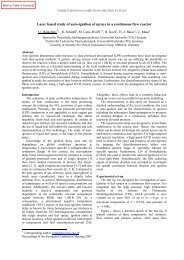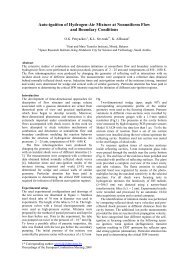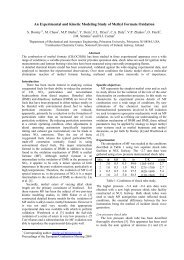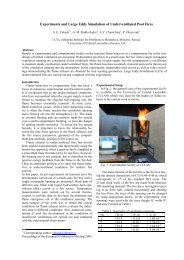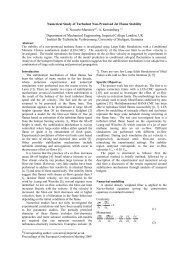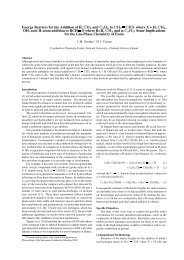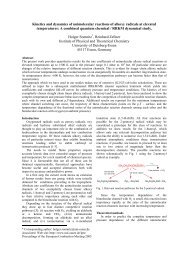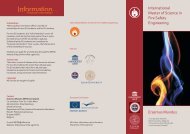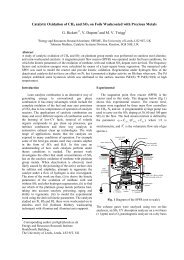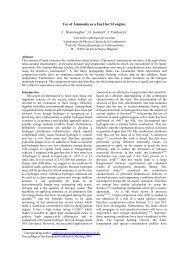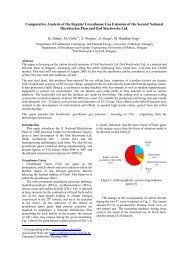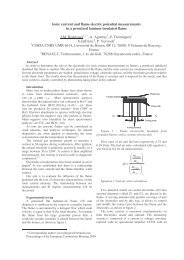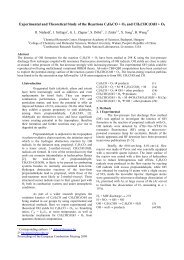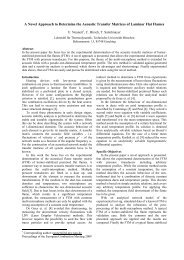Assessment of modeling approaches for the simulation of non ...
Assessment of modeling approaches for the simulation of non ...
Assessment of modeling approaches for the simulation of non ...
You also want an ePaper? Increase the reach of your titles
YUMPU automatically turns print PDFs into web optimized ePapers that Google loves.
<strong>Assessment</strong> <strong>of</strong> <strong>modeling</strong> <strong>approaches</strong> <strong>for</strong> <strong>the</strong> <strong>simulation</strong> <strong>of</strong> <strong>non</strong>-premixed and partially<br />
premixed turbulent combustion processes<br />
Jan E. Anker, Kilian Claramunt, Charles Hirsch *<br />
NUMECA International, Av. Franklin D. Roosevelt 5<br />
B-1050 Brussels, Belgium<br />
www.numeca.com<br />
Abstract<br />
This paper assesses two variants <strong>of</strong> <strong>the</strong> flamelet generated manifolds (FGM) technique as well as <strong>the</strong> Reaction-<br />
Diffusion-Manifolds (REDIM) method <strong>for</strong> <strong>the</strong> <strong>simulation</strong> <strong>of</strong> <strong>non</strong>-premixed and partially premixed turbulent<br />
combustion processes. For this purpose a framework <strong>for</strong> combustion models have been incorporated in <strong>the</strong><br />
unstructured, density-based Navier-Stokes solver FINE/Hexa. To be able to simulate combustion processes <strong>for</strong> low<br />
Mach number flow, <strong>the</strong> implemented models are used in conjunction with a time-derivative preconditioning<br />
technique. The FGM and <strong>the</strong> REDIM method are applied on a benchmark flame <strong>for</strong> purely <strong>non</strong>-premixed<br />
combustion. The <strong>for</strong>mer method is also assessed on an industry-like test case, in which fuel and oxidizer partially<br />
premix be<strong>for</strong>e combustion. A comparison <strong>of</strong> <strong>the</strong> results obtained with results using <strong>the</strong> classical flamelet method is<br />
conducted to discuss <strong>the</strong> conceptual strengths and weaknesses <strong>of</strong> <strong>the</strong> different methods.<br />
1. Introduction and objective <strong>of</strong> <strong>the</strong> paper<br />
The mixture fraction <strong>modeling</strong> approach in conjunction<br />
with flamelet tables [1] is recognized as a reliable and<br />
accurate method <strong>for</strong> <strong>the</strong> <strong>simulation</strong> <strong>of</strong> diffusion flames.<br />
As <strong>the</strong> flame-structure is calculated in a preprocessing<br />
step and thus <strong>the</strong> chemistry calculations can be kept<br />
outside <strong>of</strong> <strong>the</strong> flow solver, this method has <strong>the</strong><br />
advantage <strong>of</strong> being efficient. Due to <strong>the</strong> fast chemistry<br />
assumption which is only partially relieved by<br />
accounting <strong>for</strong> <strong>the</strong> effect <strong>of</strong> strain, this method is<br />
however limited to <strong>the</strong> use <strong>for</strong> <strong>non</strong>-premixed flow.<br />
There are several suggestions how to combine this<br />
method with a Bray-Moss-Libby (BML) model <strong>for</strong><br />
premixed combustion to also be able to also simulate<br />
partially premixed or even premixed combustion with<br />
one single approach [2]. However, <strong>the</strong>se models have<br />
<strong>the</strong> drawback, that <strong>the</strong>ir per<strong>for</strong>mance, like <strong>the</strong> BML<br />
model, depends on <strong>the</strong> adaption <strong>of</strong> <strong>the</strong> large set <strong>of</strong><br />
empirical coefficients to <strong>the</strong> particular application <strong>of</strong><br />
interest. A more fruitful approach in <strong>the</strong> development <strong>of</strong><br />
a reliable combustion model that both can handle <strong>non</strong>premixed<br />
and premixed situations, seems to be to use a<br />
manifold-based <strong>modeling</strong> technique, like <strong>the</strong> Flamelet<br />
Generated Manifolds (FGM) method [3], <strong>the</strong> FPI<br />
approach [4, 5], <strong>the</strong> ICE-PIC concept [6] or <strong>the</strong><br />
Reaction-Diffusion-Manifolds (REDIM) [7] method.<br />
All <strong>the</strong>se <strong>approaches</strong> employ tabulated chemistry in<br />
conjunction with transport-equations <strong>for</strong> <strong>the</strong> mixture<br />
fraction and one or several progress variables.<br />
In this paper <strong>the</strong> FGM and <strong>the</strong> REDIM methods will<br />
be assessed on a purely <strong>non</strong>-premixed test case as well<br />
as a configuration with partially premixed combustion.<br />
As a FGM ei<strong>the</strong>r can be constructed from premixed or<br />
<strong>non</strong>-premixed flamelets, it will be <strong>of</strong> interest to find out<br />
which choice leads to <strong>the</strong> best per<strong>for</strong>mance <strong>of</strong> <strong>the</strong><br />
method. Vreman et al. [8] compared both methods on<br />
TNF’s partially premixed Flame D [9]. As <strong>the</strong> fuel<br />
• charles.hirsch@numeca.be<br />
stream in Flame D is diluted with air, it is easy to<br />
construct premixed flamelets <strong>for</strong> a large range <strong>of</strong><br />
fuel/oxidizer mixtures. In <strong>the</strong> current paper two different<br />
test cases are chosen, <strong>for</strong> which burning premixed<br />
flamelet solutions only exist on a limited range <strong>of</strong> <strong>the</strong><br />
mixture fraction. For both test cases <strong>the</strong> results obtained<br />
by using a manifold-based method are compared to<br />
those obtained with <strong>the</strong> classical flamelet method.<br />
2. Modeling <strong>approaches</strong><br />
2.1 Governing equations<br />
In <strong>the</strong> present <strong>approaches</strong>, <strong>the</strong> RANS-equations are<br />
solved toge<strong>the</strong>r with a transport equation <strong>for</strong> <strong>the</strong> mixture<br />
fraction f and its variance g. A transport equation <strong>for</strong> <strong>the</strong><br />
progress variable Y is solved to parameterize <strong>the</strong><br />
evolution <strong>of</strong> <strong>the</strong> overall reaction. It is assumed that <strong>the</strong><br />
variance <strong>of</strong> <strong>the</strong> progress variable plays a negligible role<br />
in <strong>the</strong> turbulence-chemistry interaction compared to <strong>the</strong><br />
variance <strong>of</strong> <strong>the</strong> mixture fraction.<br />
The governing equations read as<br />
t<br />
t<br />
~ r ( ρu<br />
)<br />
r<br />
∂t<br />
ρ + ∇ ⋅ = 0<br />
~ r r ~ r ~ r<br />
∂t<br />
( ρu<br />
) + ∇ ⋅ ( ρu<br />
⊗ u −σ<br />
) = 0<br />
~ r<br />
∂t<br />
( ρf<br />
) + ∇<br />
( ρg~<br />
r<br />
∂ ) + ∇<br />
∂<br />
~ r~<br />
r~<br />
⋅ ( ρuf<br />
− ρDe∇f<br />
) = 0<br />
~ r ( ρug~<br />
r<br />
ρDe<br />
g~<br />
r~<br />
2<br />
⋅ − ∇ ) = 2De<br />
⋅ ( ∇f<br />
) − Cχ<br />
~ r ~ r ~ r r ~ ~<br />
( ρY<br />
) + ∇ ⋅ ( ρuY<br />
) = ∇ ⋅ ( ρDe∇Y<br />
) + & ωY<br />
ρg~<br />
~ ~<br />
ε / k<br />
with <strong>the</strong> velocity vector u r , <strong>the</strong> density ρ, <strong>the</strong> effective<br />
stress tensor σ , <strong>the</strong> source term <strong>of</strong> <strong>the</strong> progress variable<br />
ω& , <strong>the</strong> turbulent kinetic energy k and its dissipation<br />
Y<br />
rate ε.<br />
The RANS equations have in <strong>the</strong> current study been<br />
solved in conjunction with <strong>the</strong> standard k-ε model. A<br />
turbulent Schmidt number <strong>of</strong> σD = 0.7 has been used.
The density ρ and <strong>the</strong> molecular dynamic viscosity μ<br />
are determined via look-up tables <strong>of</strong> <strong>the</strong> <strong>for</strong>m<br />
~ ~<br />
ρ μ = F ( f , g~<br />
, Y ), ∀F<br />
∈ F(<br />
FGM, REDIM)<br />
, 1<br />
1<br />
For <strong>the</strong> case that equilibrium or flamelet tables are used,<br />
<strong>the</strong> governing transport equations are <strong>the</strong> same, except<br />
that no transport equation <strong>for</strong> <strong>the</strong> chemical progress is<br />
solved. If <strong>the</strong> latter approach is used, <strong>the</strong> combustion<br />
tables are looked up with <strong>the</strong> strain rate a instead <strong>of</strong> <strong>the</strong><br />
progress variable Y as a parameter [1].<br />
2.2 Manifold-based <strong>modeling</strong> techniques<br />
In this section, <strong>the</strong> principles behind <strong>the</strong> construction <strong>of</strong><br />
<strong>the</strong> FGM and REDIM tables are briefly explained. Even<br />
though <strong>the</strong> method <strong>of</strong> table construction is different <strong>for</strong><br />
<strong>the</strong> various <strong>approaches</strong>, <strong>the</strong> idea <strong>of</strong> representing a<br />
complex reaction mechanism by a low dimensional<br />
manifold, which is completely described by a few<br />
parameterizing variables like <strong>the</strong> mixture fraction and<br />
one or several progress variables, is <strong>the</strong> same.<br />
The flamelet generated manifolds (FGM) methods were<br />
first introduced by van Oijen [3]. As <strong>the</strong> name suggests,<br />
<strong>the</strong> idea <strong>of</strong> <strong>the</strong> method is to construct a manifold based<br />
on a set <strong>of</strong> flamelets. In <strong>the</strong> current work, <strong>the</strong> necessary<br />
flamelet libraries <strong>for</strong> <strong>the</strong> generation <strong>of</strong> FGMs have been<br />
generated using TU Eindhoven’s 1D-chemistry code<br />
Chem1D [10] toge<strong>the</strong>r with <strong>the</strong> GRI 3.0 reaction<br />
mechanism <strong>for</strong> <strong>the</strong> combustion <strong>of</strong> natural gas in air. The<br />
flamelets can ei<strong>the</strong>r represent a <strong>non</strong>-burning, a premixed<br />
propagating or a stretched <strong>non</strong>-premixed burning flame.<br />
The FGM tables used in <strong>the</strong> current work have ei<strong>the</strong>r<br />
been built from a library <strong>of</strong> premixed or from a library<br />
<strong>of</strong> <strong>non</strong>-premixed flamelets. In <strong>the</strong> following subsections,<br />
<strong>the</strong> construction process <strong>for</strong> both types <strong>of</strong> FGM will be<br />
explained.<br />
2.2.1 Premixed flamelet generated manifolds<br />
Premixed FGMs are based on a library <strong>of</strong> premixed<br />
flamelets, with each flamelet corresponding to a<br />
different mixture fraction. The main step in <strong>the</strong><br />
construction <strong>of</strong> <strong>the</strong> manifolds consists <strong>of</strong> mapping <strong>the</strong><br />
<strong>the</strong>rmochemical states <strong>of</strong> each flamelet on a grid that<br />
spans <strong>the</strong> complete physical range <strong>of</strong> <strong>the</strong> mixture<br />
fraction f and <strong>the</strong> progress variable Y. The progress<br />
variable is typically defined as a linear combination <strong>of</strong><br />
<strong>the</strong> intermediate species and <strong>the</strong> products. Vreman et al.<br />
[8] suggest using <strong>the</strong> following definition<br />
Y = Y / M + Y / M + Y / M , H<br />
H 2 O<br />
H 2O<br />
CO2<br />
CO2<br />
where Yi and Mi represent <strong>the</strong> mass fraction and <strong>the</strong><br />
molar mass <strong>of</strong> species i, respectively. In <strong>the</strong> current<br />
work, different definitions <strong>of</strong> <strong>the</strong> progress variables<br />
have been tested. It is essential to take a combination <strong>of</strong><br />
species, so that <strong>the</strong> progress variable is monotonously<br />
increasing along each flamelet.<br />
H 2<br />
2<br />
2<br />
It should be noted that since <strong>the</strong> mixture <strong>of</strong> fuel and<br />
oxidizer in <strong>the</strong> regular case are not flammable <strong>for</strong> <strong>the</strong><br />
complete range <strong>of</strong> physical values <strong>of</strong> <strong>the</strong> mixture<br />
fraction, an interpolation has to be carried out <strong>for</strong> <strong>the</strong><br />
states with a mixture fraction lying between <strong>the</strong> pure<br />
oxidizer (f = 0) and <strong>the</strong> lower flammability limit (f = fl)<br />
as well <strong>for</strong> <strong>the</strong> states having a mixture fraction between<br />
that <strong>of</strong> <strong>the</strong> upper flammability limit (f = fu) and that <strong>of</strong><br />
<strong>the</strong> pure fuel (f = 1).<br />
2.2.2 Non-premixed flamelet generated manifolds<br />
Non-premixed FGMs are created from a library <strong>of</strong><br />
burning steady-state <strong>non</strong>-premixed flamelets and one<br />
unsteady extinguishing flamelet. A steady flamelet<br />
library, which is used as a basis <strong>for</strong> <strong>the</strong> construction <strong>of</strong> a<br />
<strong>non</strong>-premixed FGM, is containing flamelets ranging<br />
from a negligible strain until a strain rate, which lies<br />
close to that <strong>of</strong> <strong>the</strong> quenching limit. To fill <strong>the</strong> statespace<br />
between <strong>the</strong> steady burning flamelet subject <strong>the</strong><br />
highest possible strain be<strong>for</strong>e extinction and <strong>the</strong> limit <strong>of</strong><br />
an unburnt mixture <strong>of</strong> fuel and oxidizer, <strong>the</strong><br />
<strong>the</strong>rmochemical states <strong>of</strong> an unsteady flamelet are used.<br />
The necessary unsteady flamelet <strong>for</strong> <strong>the</strong> generation <strong>of</strong> a<br />
<strong>non</strong>-premixed FGM is created using <strong>the</strong> steady flamelet<br />
<strong>for</strong> <strong>the</strong> highest strain as initial solution and by<br />
prescribing a strain rate that lies slightly above <strong>the</strong><br />
quenching limit, so that <strong>the</strong> flame successively dies.<br />
After a suitable definition <strong>of</strong> <strong>the</strong> progress variable has<br />
been found, <strong>the</strong> flamelet library is remapped onto a twodimensional<br />
grid spanned by <strong>the</strong> mixture fraction and<br />
<strong>the</strong> progress variable.<br />
As discussed by Vreman et al. [8], filling <strong>the</strong> <strong>non</strong>equilibrium<br />
part <strong>of</strong> <strong>the</strong> reaction domain with <strong>the</strong><br />
solution <strong>of</strong> an unsteady flamelet, leads to <strong>non</strong>smoothness<br />
in <strong>the</strong> manifold. However, <strong>the</strong> incorporation<br />
<strong>of</strong> an unsteady flamelet may be advantageous, as<br />
unsteady flamelets are known to predict intermediate<br />
species and slow chemistry well [11, 12]. In addition, it<br />
should be noted, that a library <strong>of</strong> premixed flamelets in<br />
general does cover a smaller part <strong>of</strong> <strong>the</strong> state space than<br />
<strong>the</strong> set <strong>of</strong> flamelets used <strong>for</strong> <strong>the</strong> construction <strong>of</strong> a <strong>non</strong>premixed<br />
FGM.<br />
2.2.3 REDIM-approach<br />
The Reaction-Diffusion-Manifolds (REDIM) method <strong>of</strong><br />
Bykov and Maas [7] reduces a detailed system <strong>of</strong><br />
reactive-diffusive equations by constructing an invariant<br />
manifold, which describes <strong>the</strong> dynamics <strong>of</strong> <strong>the</strong> original<br />
system after <strong>the</strong> fastest reactions have reached a quasisteady-state.<br />
The method represents an extension <strong>of</strong> <strong>the</strong><br />
Intrinsic-Low-Dimensional-Manifolds (ILDM) method<br />
<strong>of</strong> Maas and Pope [13]. The REDIM method has <strong>the</strong><br />
advantage over <strong>the</strong> ILDM method, that it does not<br />
consider <strong>the</strong> reaction as taking place in an isolated<br />
concentrated system but accounts both <strong>for</strong> <strong>the</strong> reaction<br />
and <strong>the</strong> transport and diffusion processes as well as <strong>the</strong>ir
interaction. While <strong>the</strong> ILDM-manifolds typically have a<br />
limited range <strong>of</strong> definition, which constrains <strong>the</strong>ir<br />
practical use, <strong>the</strong> look-up tables constructed with <strong>the</strong><br />
REDIM-method are defined on <strong>the</strong> complete physical<br />
range <strong>of</strong> <strong>the</strong> parameterizing variables.<br />
2.2.4 Turbulence chemistry interaction<br />
To account <strong>for</strong> <strong>the</strong> turbulence chemistry interaction, <strong>the</strong><br />
presumed β-PDF approach is used. In order to be able to<br />
pre-integrate <strong>the</strong> combustion look-up tables, <strong>the</strong>y must<br />
first be trans<strong>for</strong>med onto a square domain in <strong>the</strong><br />
independent variables. This is achieved, by re-mapping<br />
<strong>the</strong> flamelets onto <strong>the</strong> normalized progress variable<br />
* Y −Ymax<br />
( f )<br />
Y ( f , Y ) =<br />
.<br />
Y ( f ) −Y<br />
( f )<br />
max<br />
min<br />
With this trans<strong>for</strong>mation, <strong>the</strong> <strong>the</strong>rmochemical states are<br />
defined on a square domain with mixture fraction and<br />
<strong>the</strong> normalized progress variable as independent<br />
parameterizing variables, both going from zero to unity<br />
on <strong>the</strong> whole physical domain. In <strong>the</strong> present approach<br />
statistical independence <strong>of</strong> <strong>the</strong> mixture fraction and <strong>the</strong><br />
normalized progress variable is assumed. It is<br />
fur<strong>the</strong>rmore assumed that <strong>the</strong> fluctuations in <strong>the</strong><br />
normalized progress variables are negligible. After <strong>the</strong><br />
pre-integration, <strong>the</strong> tables depend consequently on <strong>the</strong><br />
mixture fraction f, its variance g and <strong>the</strong> normalized<br />
progress variable Y * . Since <strong>the</strong> transport equations are<br />
still solved <strong>for</strong> <strong>the</strong> <strong>non</strong>-normalized progress variable Y,<br />
a normalization <strong>of</strong> <strong>the</strong> latter solution variable is needed,<br />
be<strong>for</strong>e <strong>the</strong> combustion tables can be looked up.<br />
2.3 Numerical method<br />
The s<strong>of</strong>tware environment FINE/Hexa is used <strong>for</strong> <strong>the</strong><br />
solution <strong>of</strong> <strong>the</strong> governing system <strong>of</strong> equations <strong>for</strong> flow,<br />
turbulence and combustion on unstructured hexahedral<br />
grids. The flow solver applies a cell-centered finite<br />
volume method and time-stepping <strong>for</strong> <strong>the</strong> integration <strong>of</strong><br />
<strong>the</strong> governing flow equations. The RANS equations are<br />
discretized centrally by means <strong>of</strong> <strong>the</strong> Jameson, Schmidt<br />
and Turkel scheme [14]. In order to ensure bounded and<br />
monotonous solutions <strong>for</strong> <strong>the</strong> combustion variables, <strong>the</strong><br />
combustion transport equations are discretized using a<br />
second order accurate upwind scheme. Since <strong>the</strong> density<br />
is not dependent on <strong>the</strong> pressure, an artificial<br />
compressibility approach is used <strong>for</strong> <strong>the</strong> temporal<br />
discretization <strong>of</strong> <strong>the</strong> RANS equations. All transport<br />
equations are advanced in time using an explicit 4-stage<br />
Runge-Kutta scheme. For convergence acceleration a<br />
local time-stepping procedure, implicit residual<br />
smoothing technique and agglomeration multigrid<br />
method are used.<br />
The mixture fraction approach implemented in<br />
FINE/Hexa has been verified and validated on a large<br />
series <strong>of</strong> test cases ranging from <strong>the</strong> flat diffusing plate,<br />
<strong>non</strong>-reacting jets, and several <strong>of</strong> TNF’s target flames [9]<br />
3<br />
to industrial test cases. The framework <strong>for</strong> <strong>the</strong> approach<br />
used in this study has been validated using <strong>non</strong>premixed<br />
FGMs on a laminar confined flame [15] and a<br />
turbulent piloted CH4/air diffusion flame [9,16].<br />
3. Results and discussion<br />
3.1 Bluff-body stabilized flame<br />
As a first test-case, <strong>the</strong> bluff-body stabilized flame <strong>of</strong><br />
<strong>the</strong> University <strong>of</strong> Sydney [17] is considered. The<br />
configuration consists <strong>of</strong> a burner with a cylindrical<br />
bluff-body with diameter <strong>of</strong> Db = 50 mm. From <strong>the</strong><br />
center <strong>of</strong> <strong>the</strong> body, <strong>the</strong> fuel is ejected into <strong>the</strong><br />
surrounding, c<strong>of</strong>lowing air through a nozzle with a<br />
diameter <strong>of</strong> d = 3.6 mm. The fuel consists <strong>of</strong> 50% H2<br />
and 50% CH4 by volume.<br />
The geometry is shown in Fig. 1.a, which also indicates<br />
<strong>the</strong> streamlines <strong>of</strong> <strong>the</strong> flow. This configuration has a<br />
complex flow field and strong effects <strong>of</strong> turbulencechemistry<br />
interaction. In Fig. 1.b a picture <strong>of</strong> <strong>the</strong> flame<br />
is shown.<br />
(a) (b)<br />
Fig.1: Geometry <strong>of</strong> <strong>the</strong> burner and shape <strong>of</strong> <strong>the</strong> bluffbody<br />
stabilized flame<br />
The experiments were carried out <strong>for</strong> several operating<br />
conditions; in <strong>the</strong> present paper <strong>the</strong> HM1E case is<br />
studied, <strong>for</strong> which <strong>the</strong> fuel jet has a bulk velocity <strong>of</strong> 108<br />
m/s and <strong>the</strong> c<strong>of</strong>lowing air has a velocity <strong>of</strong> 35 m/s.<br />
The bluff-body stabilized flame was modeled using an<br />
axi-symmetrical, structured grid consisting <strong>of</strong> 15000<br />
cells. The fuel nozzle was not modeled; <strong>the</strong><br />
computational domain starts at <strong>the</strong> end face <strong>of</strong> <strong>the</strong> bluffbody.<br />
The computational has a constant radial width <strong>of</strong> r<br />
= 1.2 Db and ends downstream at an axial distance <strong>of</strong> x<br />
= 5 Db from <strong>the</strong> bluff-body. The defined bulk velocity <strong>of</strong><br />
35 m/s is prescribed as an average inlet velocity <strong>of</strong> <strong>the</strong><br />
fuel with a power-law <strong>for</strong> pipe flow. The inlet<br />
velocities <strong>of</strong> <strong>the</strong> c<strong>of</strong>low were prescribed using <strong>the</strong><br />
available measurement data. To account <strong>for</strong> <strong>the</strong> round<br />
jet anomaly <strong>of</strong> <strong>the</strong> standard k-ε turbulence model, <strong>the</strong><br />
Cε1 constant was set to 1.6.
This test case was simulated using <strong>non</strong>-premixed and<br />
premixed FGM tables as well as using one REDIM<br />
table that was kindly provided to us by Pr<strong>of</strong>. U. Maas.<br />
Since <strong>the</strong> REDIM table given to us uses 2 2 / CO CO M Y Y =<br />
as a definition <strong>of</strong> <strong>the</strong> progress variable, this definition<br />
was <strong>for</strong> consistency reasons also employed in <strong>the</strong> <strong>non</strong>premixed<br />
and premixed FGMs used in this study. Using<br />
definitions <strong>of</strong> <strong>the</strong> progress variables in <strong>the</strong> construction<br />
<strong>of</strong> <strong>non</strong>-premixed FGMs, which also included <strong>the</strong> mass<br />
fraction <strong>of</strong> H2O, CO2, H and/or H2, lead only to minor<br />
improvements in <strong>the</strong> results. Both FGMs and <strong>the</strong><br />
REDIM were tabulated on an equidistant grid with<br />
respectively 201 nodes in <strong>the</strong> mixture fraction and <strong>the</strong><br />
progress variable direction.<br />
In <strong>the</strong> following a comparison between <strong>the</strong> <strong>simulation</strong>s<br />
and <strong>the</strong> experimental data is shown. We are <strong>for</strong> brevity<br />
omitting <strong>the</strong> results <strong>for</strong> <strong>the</strong> flow field and <strong>the</strong> results <strong>for</strong><br />
<strong>the</strong> mixture fraction and its variance. It should be noted<br />
that those results are nearly invariant <strong>of</strong> <strong>the</strong> chosen<br />
model and are fur<strong>the</strong>rmore in a very good agreement<br />
with <strong>the</strong> measurement data. The interested reader may<br />
however confer <strong>the</strong> proceedings <strong>of</strong> <strong>the</strong> 8 th International<br />
Workshop on Turbulent Nonpremixed Flames [9] <strong>for</strong><br />
<strong>the</strong> computational results <strong>of</strong> <strong>the</strong> flow field.<br />
Fig. A1.a-f (on page 6) show <strong>the</strong> radial pr<strong>of</strong>iles <strong>of</strong> <strong>the</strong><br />
simulated and measured temperatures and <strong>the</strong> mass<br />
fractions CO2 and CO at <strong>the</strong> axial distances x = 0.26 Db<br />
and x = 1.3 Db. The experimental data are shown in<br />
bullets.<br />
In Fig. A1.a <strong>the</strong> temperature pr<strong>of</strong>iles at <strong>the</strong> station<br />
closest to <strong>the</strong> bluff-body are shown. The temperature is<br />
significantly underpredicted on <strong>the</strong> rich side <strong>of</strong> <strong>the</strong><br />
flame when equilibrium tables are used, as this method<br />
do not account <strong>for</strong> <strong>the</strong> diffusion effects, which tend to<br />
raise <strong>the</strong> temperature on <strong>the</strong> rich side <strong>of</strong> <strong>non</strong>-premixed<br />
flames. All <strong>simulation</strong>s overpredict <strong>the</strong> temperature and<br />
predict a peak in <strong>the</strong> temperature in <strong>the</strong> outer shear layer<br />
at r/Rb≈1. One possible reason <strong>for</strong> <strong>the</strong> general<br />
overprediction <strong>of</strong> <strong>the</strong> temperature may be due to <strong>the</strong><br />
<strong>modeling</strong> <strong>of</strong> <strong>the</strong> end face <strong>of</strong> <strong>the</strong> bluff-body as an<br />
adiabatic wall. As can be seen from Fig. A1.b, all<br />
models, except <strong>the</strong> equilibrium approach, predict <strong>the</strong><br />
temperature distributions fur<strong>the</strong>r downstream<br />
(x/Db=1.3) well.<br />
The Figs. A1.c and A1.d, which show <strong>the</strong> mass fraction<br />
<strong>of</strong> CO2, reveal that <strong>the</strong> use <strong>of</strong> a premixed FGM leads to<br />
a significant underprediction <strong>of</strong> <strong>the</strong> <strong>for</strong>mation <strong>of</strong> CO2<br />
both close <strong>the</strong> bluff-body as well as far<strong>the</strong>r downstream,<br />
whereas <strong>the</strong> flamelet approach only leads to a slight<br />
underprediction. The use <strong>of</strong> REDIM tables leads to a<br />
slight overprediction <strong>of</strong> <strong>the</strong> CO2, whereas <strong>the</strong> use <strong>of</strong><br />
<strong>non</strong>-premixed FGMs leads to a good agreement<br />
between <strong>the</strong> computed and measured CO2 mass<br />
fractions at all axial stations. Figs. A1.e and A1.f, in<br />
which <strong>the</strong> distributions <strong>of</strong> <strong>the</strong> mass fraction <strong>for</strong> <strong>the</strong><br />
4<br />
carbon monoxide are displayed, demonstrate that <strong>the</strong><br />
<strong>simulation</strong> using <strong>non</strong>-premixed FGMs outper<strong>for</strong>m both<br />
<strong>the</strong> classical flamelet approach as well as <strong>the</strong> method<br />
using premixed FGMs.<br />
The inferior predictive per<strong>for</strong>mance <strong>of</strong> <strong>the</strong> premixed<br />
FGM method may be caused by <strong>the</strong> fact, that <strong>the</strong><br />
premixed FGM table is only based on flamelets <strong>for</strong><br />
mixture fractions lying between f = 0.02 and f = 0.4.<br />
Outside <strong>of</strong> this range, <strong>the</strong> FGM is built by interpolation<br />
between <strong>the</strong> burning flamelet and <strong>the</strong> states <strong>of</strong> <strong>the</strong> pure<br />
streams. The <strong>non</strong>-premixed FGMs are on <strong>the</strong> o<strong>the</strong>r hand<br />
based on a library <strong>of</strong> steady-state flamelets and one<br />
unsteady flamelet that covers all possible values <strong>for</strong> <strong>the</strong><br />
mixture fraction and <strong>the</strong> progress variable. Thus, <strong>for</strong><br />
purely <strong>non</strong>-premixed combustion, <strong>non</strong>-premixed FGMs<br />
should preferably be used. It should be noted, that <strong>the</strong><br />
limitations <strong>of</strong> <strong>the</strong> approach used <strong>for</strong> <strong>the</strong> construction <strong>of</strong><br />
premixed FGMs will diminish <strong>for</strong> partially-premixed<br />
configurations and eventually disappear <strong>for</strong> purely<br />
premixed combustion.<br />
The use <strong>of</strong> REDIM tables lead only to a fair agreement<br />
between <strong>the</strong> measurements and our <strong>simulation</strong>s. It<br />
would be worthwhile to investigate if <strong>the</strong> use <strong>of</strong> <strong>the</strong><br />
REDIM method with ano<strong>the</strong>r choice <strong>for</strong> <strong>the</strong> progress<br />
variable, multiple progress variables and/or <strong>the</strong> use <strong>of</strong><br />
<strong>the</strong> strain as an additional parameter would yield an<br />
improvement in <strong>the</strong> predictive per<strong>for</strong>mance <strong>of</strong> <strong>the</strong><br />
method.<br />
3.2 Generic gas turbine combustor<br />
To assess <strong>the</strong> models on a test case under partially<br />
premixed conditions, <strong>the</strong> Generic Gas Turbine (GGT)<br />
combustor <strong>of</strong> TU Darmstadt was simulated. In this<br />
configuration, preheated, primary air (Tox = 623 K)<br />
enters <strong>the</strong> combustion chamber through a Turbomeca<br />
swirler nozzle. The combustor is fuelled with pure<br />
methane (Tf = 368 K) and <strong>the</strong> combustion is operated at<br />
a pressure <strong>of</strong> 2 bar. After <strong>the</strong> primary reaction zone,<br />
secondary air is fed into <strong>the</strong> combustion chamber with a<br />
temperature that equals that <strong>of</strong> <strong>the</strong> primary air. Fig. 2<br />
shows a sketch <strong>of</strong> <strong>the</strong> test rig.<br />
Fig. 2: Sketch <strong>of</strong> <strong>the</strong> GGT combustor testrig [18]<br />
The combustion process in this configuration was<br />
investigated experimentally by Janus [18] and<br />
numerically by Wegner [19]. There are time-resolved
experimental data <strong>of</strong> <strong>the</strong> velocity components, <strong>the</strong><br />
temperature and <strong>the</strong> mixture fraction available. By OH<br />
PLIF experiments it has been established, that <strong>the</strong> flame<br />
in <strong>the</strong> current test cases exhibits a lifting <strong>of</strong><br />
approximately 20 mm.<br />
The combustor including <strong>the</strong> nozzle was discretized<br />
with a hexahedral mesh consisting <strong>of</strong> 300.000 cells. To<br />
avoid recirculation at <strong>the</strong> outlet boundary, <strong>the</strong><br />
computational domain was extended by a straight<br />
extrusion <strong>of</strong> <strong>the</strong> outlet duct. This case was modeled<br />
using a flamelet library, a <strong>non</strong>-premixed FGM and a<br />
premixed FGM. For both FGMs <strong>the</strong> following definition<br />
was used <strong>for</strong> <strong>the</strong> progress variable Y:<br />
Y = YCO2<br />
/ M CO2<br />
+ YH<br />
2O<br />
/ M H 2O<br />
In Fig. 3. <strong>the</strong> predicted temperatures in a cut through <strong>the</strong><br />
midplane <strong>of</strong> <strong>the</strong> combustor are shown <strong>for</strong> <strong>the</strong> flamelet<br />
<strong>simulation</strong> and <strong>for</strong> <strong>the</strong> computation in which a <strong>non</strong>premixed<br />
FGM table was used. The flamelet <strong>simulation</strong><br />
predicts that <strong>the</strong> flame is attached. This result is not<br />
surprising as inherently with <strong>the</strong> flamelet approach fast<br />
chemistry is assumed. In <strong>the</strong> <strong>simulation</strong> in which a <strong>non</strong>premixed<br />
FGM is used, a lifting <strong>of</strong> <strong>the</strong> flame is<br />
predicted. The contour plot <strong>of</strong> <strong>the</strong> <strong>simulation</strong> <strong>for</strong> <strong>the</strong><br />
premixed FGM is omitted, as <strong>the</strong> temperature contours<br />
are very close to that <strong>of</strong> <strong>the</strong> flamelet <strong>simulation</strong>s. In Fig.<br />
A2 a comparison between <strong>the</strong> results <strong>of</strong> Wegner [19]<br />
using LES and <strong>the</strong> results obtained in this study with<br />
RANS are shown. The LES results are in good<br />
agreement with <strong>the</strong> measurements and can thus be used<br />
as a reference. The comparison <strong>of</strong> computational results<br />
confirms that <strong>the</strong> use <strong>of</strong> <strong>non</strong>-premixed FGMs in <strong>the</strong><br />
RANS context lead to a better predictability than when<br />
<strong>the</strong> flamelet approach is used.<br />
Fig. 3: Simulated temperature distributions in <strong>the</strong> GGT<br />
combustor using <strong>the</strong> flamelet and <strong>the</strong> FGM approach<br />
4. Conclusions<br />
In <strong>the</strong> present paper <strong>the</strong> use <strong>of</strong> various reactednessmixedness<br />
<strong>approaches</strong> were assessed on a benchmark<br />
flame <strong>for</strong> purely <strong>non</strong>-premixed combustion and a<br />
industry-like test case in which partially premixing <strong>of</strong><br />
fuel and oxidizer is present. The results show that <strong>the</strong><br />
5<br />
<strong>non</strong>-premixed FGM-approach is more accurate than <strong>the</strong><br />
standard flamelet approach. The <strong>non</strong>-premixed FGMs<br />
account <strong>for</strong> finite rate effects and are thus able to<br />
accurately resolve <strong>the</strong> <strong>for</strong>mation <strong>of</strong> intermediate species<br />
as well as <strong>the</strong> lifting <strong>of</strong> partially premixed flames. The<br />
use <strong>of</strong> REDIM approach and <strong>the</strong> use <strong>of</strong> premixed FGM<br />
tables did not prove to have significant advantages over<br />
<strong>the</strong> use <strong>of</strong> flamelets. Possible reasons <strong>for</strong> this have been<br />
explained in <strong>the</strong> paper. In <strong>the</strong> on-going work, this will<br />
be investigated fur<strong>the</strong>r by incorporating test cases <strong>for</strong><br />
stratified and premixed flames.<br />
Acknowledgement<br />
The authors would like to thank Pr<strong>of</strong>. U. Maas (ITT,<br />
University <strong>of</strong> Karlsruhe) <strong>for</strong> providing us a REDIM<br />
table <strong>for</strong> <strong>the</strong> TNF Bluff-body test case. The authors<br />
would also like to thank Mr. Giel Ramaekers, Dr. Jeroen<br />
van Oijen and Pr<strong>of</strong>. de Goey (TU Eindhoven) <strong>for</strong><br />
providing us knowledge in <strong>the</strong> generation <strong>of</strong> FGM and<br />
training <strong>the</strong> first author in <strong>the</strong> use <strong>of</strong> Chem1D.<br />
Fur<strong>the</strong>rmore, <strong>the</strong> authors are obliged to Dr. Bernhard<br />
Wegner <strong>for</strong> providing us with results <strong>of</strong> his LESs.<br />
References<br />
[1] N. Peters, Turbulent Combustion, Cambridge<br />
University Press, 2000<br />
[2] A. Maltsev, PhD Thesis, TU Darmstadt, 2003<br />
[3] J. A. van Oijen, PhD Thesis, TU Eindhoven, 2002<br />
[4] O. Gicquel, N. Darabiha, D. Thevenin, PCI 28<br />
(2000), 1901-1908<br />
[5] B. Fiorina; R. Baron, O. Gicquel, D. Thevenin, S.<br />
Carpentier, N. Darabiha, Combustion Theory and<br />
Modelling 7 (2003), 449 - 470<br />
[6] Z. Ren, S. B. Pope, A. Vladimirsky, J. M.<br />
Guckenheimer, PCI 31 (2007), 473-481<br />
[7] V. Bykov, U. Maas, Combustion Theory and<br />
Modelling 11 (2007), 839-862<br />
[8] A. W. Vreman, B. A. Albrecht, J. A. van Oijen, L.<br />
P. H. de Goey, R. J. M. Baastians, Combust. Flame 153<br />
(2008), 394-416<br />
[9] Proceedings <strong>of</strong> <strong>the</strong> TNF workshop, Sandia National<br />
Laboratories, Livermore, CA, www.ca.sandia.gov/TNF.<br />
[10] B. Somers, PhD-<strong>the</strong>sis, TU Eindhoven, 1994<br />
[11] K. Claramunt, R. Consul, D. Carbonell, C. D.<br />
Perez-Segarra, Combust. Flame 145 (2006), 845-862<br />
[12] H. Pitsch, Combust. Flame 123 (2000), 358-374<br />
[13] U. Maas, S. B. Pope, Combust. Flame 88<br />
(1992), 239-264<br />
[14] A. Jameson, W. Schmidt, E. Turkel, AIAA Paper<br />
81-1259, 1981<br />
[15] C. S. McEnally, L. D. Pfefferle, Combust. Sci.<br />
Technol., 116:183-209, 1996<br />
[16] R. S. Barlow, J. H. Frank, PCI 27 (1998), 1087-<br />
1095<br />
[17] B. Dally, A. Masri, R. S. Barlow, G. Fiechtner,<br />
Combust. Flame 114 (1998), 119-148<br />
[18] B. Janus, PhD Thesis, TU Darmstadt, 2005<br />
[19] B. Wegner, PhD Thesis, TU Darmstadt (2006)
(a) (b)<br />
(c) (d)<br />
(e) (f)<br />
Fig. A1: TNF Bluff-body stabilized flame: Comparison <strong>of</strong> <strong>the</strong> computational and <strong>the</strong> experimental results<br />
Fig. A2: GGT combustor: (Left) mixture fraction, (right) temperature at several axial stations.<br />
Comparison <strong>of</strong> <strong>the</strong> RANS results obtained in this study with LES <strong>of</strong> Wegner [19]<br />
6



